Provider credentialing is the process of verification of competency, and if the provider wants to start early, the payers won't accept the application to begin credentialing. It typically takes 3 to 6 months or longer as some plans do not want to expand their payment exposure.
It can be tricky that providers cannot see the patients with the insurance plans by the time credentialing gets done, as they will not receive reimbursement for any services rendered. The patient cannot get treatment from an out-of-network provider if they carry insurance because the services will not get covered.
Therefore, the process can lead to revenue loss if approached carelessly or incorrectly. But on the other hand, the credentialing system can add benefits like increasing patient base, more services offered, free advertising network through the insurance company, preferred provider by the insurance company, etc.
Things to avoid while waiting for credentialing
What to do while it is affecting the business?
- Firstly, the provider can create the bill under an enrolled provider's NPI as a supervisor. However, which will increase their utilization significantly, alarming the payer that something went wrong.
- Secondly, the patient can verify the enrolled provider's name on the EOB and the service provider. That calls for an explanation or disciplinary action against the provider. That is a red flag, and you do not want to do that ever.
- Thirdly, the payer can ask for the appointment schedule details to support the service and proof of legitimacy.
Things to do while waiting for credentialing
- Confirm with the insurance plans if they accept the statement of supervision and officially let you bill from a provider enrolled in the insurance plan while the new provider credentialing is underway. This way, the provider can start seeing the patients within the regulations.
- Providers can see Medicare and self-pay patients right away. Enroll new providers in Medicare on paper, in the old-fashioned way, and get paid. Medicare allows providers to retro bill back 30 days from the receiving date of their Medicare application at the MACs (Medicare Administrative Contractor) office. In case of any discrepancy, you can always prove by Return Receipt Requested response.
- Many providers also enroll in Medicaid and accept retro billing. Check that state's rule to avoid red flags.
- Many providers prefer offering a complimentary meet and greet to potential patients who want to visit new providers once the credentialing gets awarded.
- Interact with other providers and meet the community while credentialing is underway. It is an appropriate and feasible way to prepare long before and start getting the reference.
- Provider credentialing doesn't come with any shortcuts. Therefore, employ the web team to help you produce trending articles and blogs to ensure you can perform specific procedures.
- It is worth doing the idea to see some patients for free and get some word of mouth. In this manner, the practice moves along, and you get to meet the community. In addition, that helps the provider to focus on delivering care to the patients.
